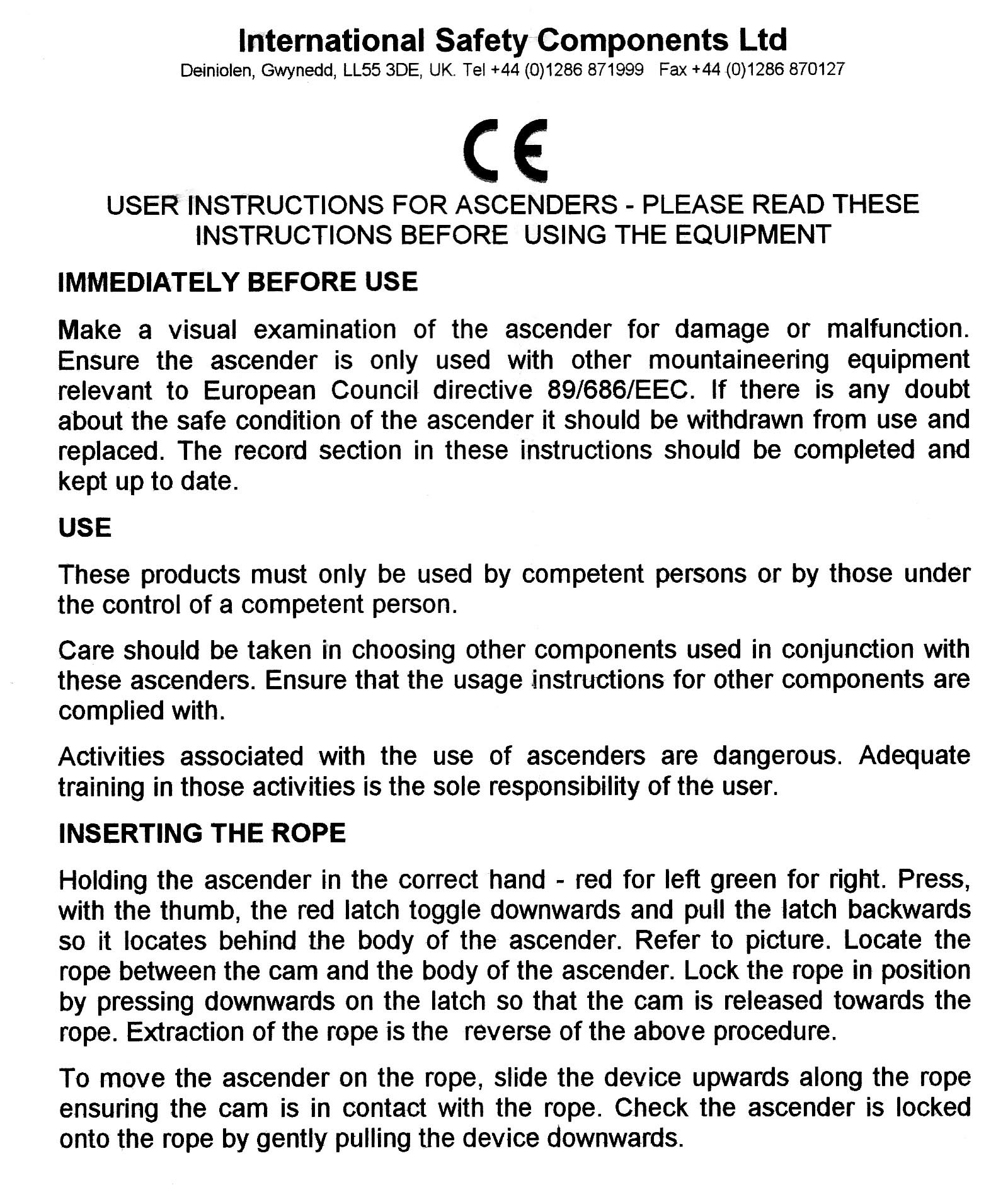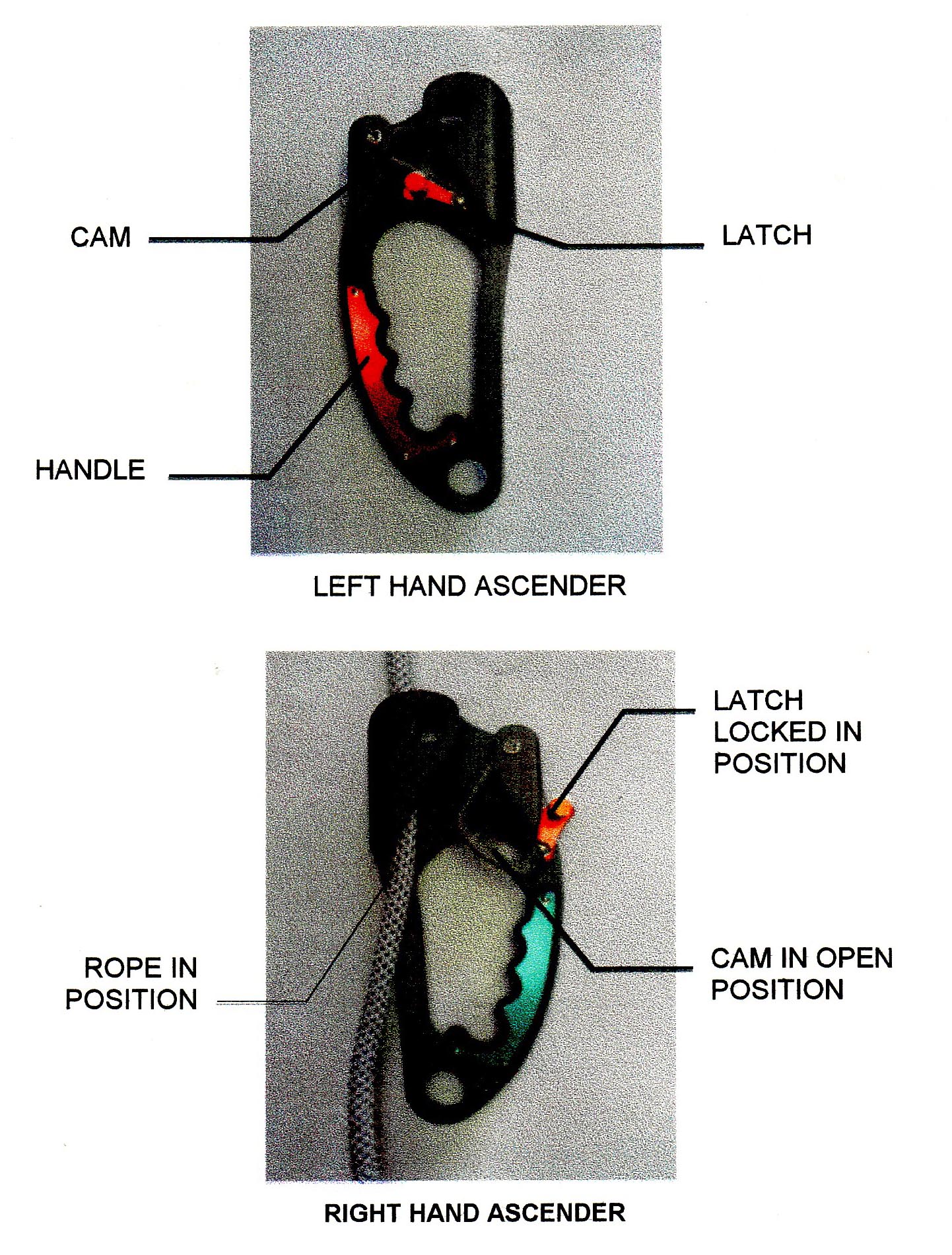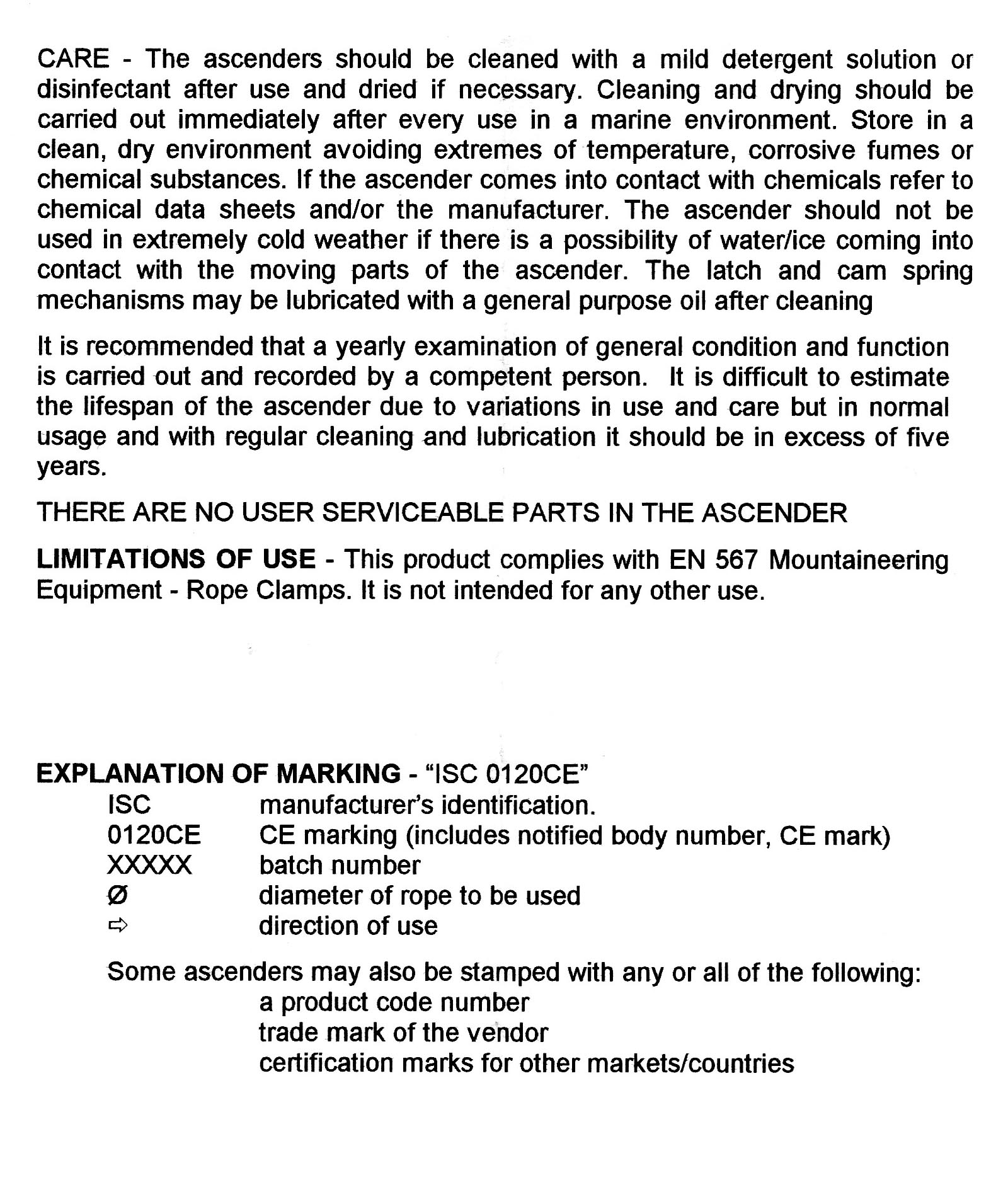Overview
[ Top
| Version B
| RP240
| Return to H.E.C. Ascenders
]
Big Wall, Version A
(#145, 2211)
Technical Details
I acquired this pair of ascenders from Mountain Tools in 1999. I acquired another pair in 2017 as part of Bob Thrun’s collection.
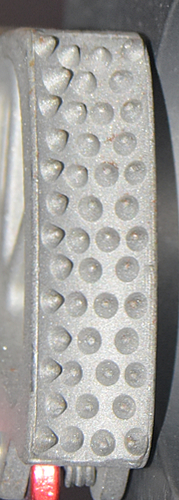 The shell is milled from a custom aluminum extrusion and hard-coated.
The extrusion and overall rounded shape of the ascender are similar
to the S.R.T. A1 Explorer. Like the S.R.T. (and the C.M.I.),
the extrusion direction is oriented parallel to the vertical axis
of the ascender, and contains two opposing channels. One channel
is rounded and becomes the rope channel., the other is square
and holds the cam. The angled hand hole is roomy, and a rubberized
plastic grip with aluminum insets is riveted to the frame. A 20 mm
hole is drilled at the bottom and a 16.2 by 20 mm. hole is milled
through both sides of the rope channel. The hand hole is made
a little wider than on the C.M.I. 5000
, so the rope channel barely protrudes from the ascender body
as on the C.M.I. 5000 series and S.R.T. Caver/climber series.
The shell is milled from a custom aluminum extrusion and hard-coated.
The extrusion and overall rounded shape of the ascender are similar
to the S.R.T. A1 Explorer. Like the S.R.T. (and the C.M.I.),
the extrusion direction is oriented parallel to the vertical axis
of the ascender, and contains two opposing channels. One channel
is rounded and becomes the rope channel., the other is square
and holds the cam. The angled hand hole is roomy, and a rubberized
plastic grip with aluminum insets is riveted to the frame. A 20 mm
hole is drilled at the bottom and a 16.2 by 20 mm. hole is milled
through both sides of the rope channel. The hand hole is made
a little wider than on the C.M.I. 5000
, so the rope channel barely protrudes from the ascender body
as on the C.M.I. 5000 series and S.R.T. Caver/climber series.
The cam is a plated skeletonized, reinforced stainless steel
casting with a (4.3)^6(4) conical tooth count. The tooth axes
are perpendicular to the cam face. The teeth are well-formed except
that the top inner tooth on my right ascender is missing. The
cam, cam spring, and a cam housing are mounted on a 5 mm. roll
rivet. The cam housing is a piece of thin sheet metal bent to
cover the top of the cam channel and serve as a spacer along the
sides of the cam. The top of the housing is flat instead of indented
(compare it with the S.R.T. Caver/climber
series). The cam safety is a spring-loaded piece of 3 mm. red
anodized aluminum mounted on a 3 mm. stainless steel rivet placed
through two tabs on the base of the cam. A small thumb knob is
staked to the safety. The knob is turned to give a contoured grip.
The safety is placed so that it does not interfere with one’s
hand in the handle.
The back of the frame is stamped "BATCH No 00532."
The aluminum inset on the front side of the grip is marked with
an arrow pointing up, "ISC UK" and "0120CE."
The rear inset is marked "ØROPE MIN 9mm - 13mm MAX."
The I.S.C. is a very well made ascender. My first impression
was "Wow!, this is a solid ascender." I have not broken
an I.S.C. ascender, but the frame is undoubtedly very strong.
It certainly won't have the "bending over the lip" problem
that stamped-frame ascenders have. Perhaps it is too strong, because
this is a very heavy ascender - only Version B and the nearly identical PMI Puma outweigh it. The hard coat finish
is a nice touch, and the ascender should resist wear very well.
The sling attachment holes could use some more beveling. The
sling attachment holes could theoretically have the same safety
problem described for the Clog ascender,
so I don't recommend using carabiners in them. The upper frame
is still more difficult to grasp from above than either the Jumar
or the small C.M.I. UltrAscender. This
latter point is more important than having an upper attachment
hole available.
The cam is very well made, reminiscent of Jumar’s.
I suspect that it is also quite strong. I'm not thrilled with
semi-tubular rivets for cam pivots. I.S.C. should consider using a grooved
pin and external retaining ring similar to the C.M.I.
design. The cam housing is lightweight and crude, but it doesn't
serve any critical function so I'm not too concerned with its
design. If you want, take a hammer and dent the housing to limit
the cam’s closing so that the teeth do not hit the inside of the
rope channel. It may even be possible to eliminate the cam housing
completely and substitute two washers, or even widen the cam a
bit and eliminate them too. The main drawback is that the cam
housing helps keep mud out of the cam pivot, and eliminating the
housing might cause the ascender to jam more easily in muddy conditions.
The ascender cam can be opened by either hand. The cam safety
can easily be operated with the thumb of the normal hand (right
hand for right-hand ascender), and the cam opened in one smooth
motion. Opening with the opposite hand is easily done with the
index finger, but the sharp end of the cam safety spring will
most likely puncture the skin at the tip of the finger. The safety
is the only part of the ascender that appears flimsy, and although
I suspect it will hold up well, the one on the is S.R.T.
A1 Explorer better. I've seen too many broken plastic ones
on other ascenders to enjoy that technological "improvement."
The safety can be hooked over the cam channel to hold the cam
completely open. There is no partial cam hold open feature, nor
is one needed.
In general, this is a very well made, rugged ascender which
is suitable for a wide variety of uses. Too bad the weight wasn't
cut in half.
[ Top
| Version A
| RP240
| Return to H.E.C. Ascenders
]
Big Wall, Version B
(#287, 2208)
Technical Details
I acquired a left-handed Version B new on eBay from Michael McGuinn in
2009.
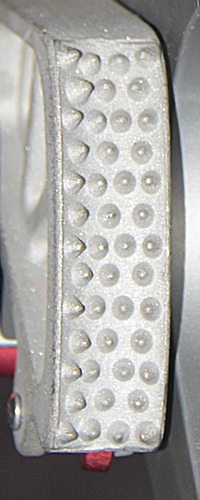 This is essentially the same as the P.M.I. Puma and Yates ascenders (the right ascender in the photographs is a Yates ascender). My Version B is 218 mm. tall, 82 mm. wide, 32 mm. thick, and weighs 369 g. The shell is milled from a custom aluminum extrusion and hard-coated.
The extrusion and overall rounded shape of the ascender are similar
to the S.R.T. A1 Explorer. Like the S.R.T. (and the C.M.I.),
the extrusion direction is oriented parallel to the vertical axis
of the ascender, and contains two opposing channels. One channel
is rounded and becomes the rope channel; the other is square
and holds the cam. The rope channel is 15 mm. wide. The angled hand hole is roomy, and a rubberized
plastic grip with aluminum insets is riveted to the frame. A 20 mm.
hole and a 13.5 mm. hole are drilled at the bottom and a 16.2 by 20 mm. hole is
milled through both sides of the rope channel. The hand hole is
made a little wider than on the C.M.I. 5000, so the rope channel barely protrudes from the ascender body
as on the C.M.I. 5000 series and S.R.T. Caver/climber series.
This is essentially the same as the P.M.I. Puma and Yates ascenders (the right ascender in the photographs is a Yates ascender). My Version B is 218 mm. tall, 82 mm. wide, 32 mm. thick, and weighs 369 g. The shell is milled from a custom aluminum extrusion and hard-coated.
The extrusion and overall rounded shape of the ascender are similar
to the S.R.T. A1 Explorer. Like the S.R.T. (and the C.M.I.),
the extrusion direction is oriented parallel to the vertical axis
of the ascender, and contains two opposing channels. One channel
is rounded and becomes the rope channel; the other is square
and holds the cam. The rope channel is 15 mm. wide. The angled hand hole is roomy, and a rubberized
plastic grip with aluminum insets is riveted to the frame. A 20 mm.
hole and a 13.5 mm. hole are drilled at the bottom and a 16.2 by 20 mm. hole is
milled through both sides of the rope channel. The hand hole is
made a little wider than on the C.M.I. 5000, so the rope channel barely protrudes from the ascender body
as on the C.M.I. 5000 series and S.R.T. Caver/climber series.
The cam is a plated skeletonized, reinforced stainless steel
casting with a (4.3)^6(4) conical tooth count. The cam radius increases from 45 to 62 mm. over an angle of 41°, giving a 24° cam angle. The tooth axes
are perpendicular to the cam face. The teeth are well-formed. The
cam, cam spring, and a cam housing are mounted on a 5 mm.
semi-tubular rivet. The cam housing is a piece of thin sheet metal bent
to cover the top of the cam channel and serve as a spacer along
the sides of the cam. The top of the housing is flat instead of
indented (compare it with the S.R.T. Caver/climber
series). The cam safety is a spring-loaded piece of 3 mm.
red anodized aluminum mounted on a 3 mm. stainless steel
rivet placed through two tabs on the base of the cam. A small
thumb knob is staked to the safety. The knob is turned to give
a contoured grip. The safety is placed so that it does not interfere
with one’s hand in the handle.
The front of the rope channel has a milled up-pointing arrow. The back of the frame is stamped "07/210/3784" in dot-matrix font. The aluminum inset
on the front side of the grip is marked with an arrow pointing
up, an ISC logo, and "0120CE."
The rear inset is marked "ø ROPE MIN9mm-13mm MAX."
Since this is essentially the same as the P.M.I. Puma and Yates ascenders, my comments on them apply to this one as well. The up-pointing arrow is unnecessary, but does no harm. I find it curious that two essentially identical ascenders from the same company have labels indicating that they fit different size ropes.
[ Top
| Version A
| Version B
| Return to H.E.C. Ascenders
]
RP240
(#2024, 2209)
Technical Details
I acquired a right-hand International Safety Components RP240 from Aarond Reagan in 2015. I acquired a pair in 2017 as part of Bob Thrun’s collection.
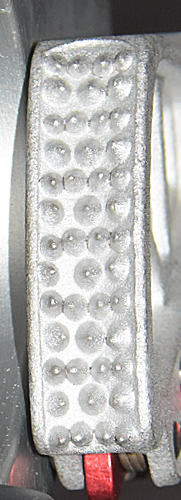 The RP240 is 217 mm. tall, 84 mm. wide, 35 mm. thick, and weighs 365 g. It is essentially the same as Version B with the addition of a safety pin that keeps the cam from opening far enough to let the rope release. The 4.85 mm. in diameter and 35.3 mm. long, and has a spring-loaded ball to secure it in a 5 mm. hole drilled below the cam axle. A 1.5 mm. plastic-covered stainless steel cable connects the pin to a hole in the shell, above the hand grip.
The RP240 is 217 mm. tall, 84 mm. wide, 35 mm. thick, and weighs 365 g. It is essentially the same as Version B with the addition of a safety pin that keeps the cam from opening far enough to let the rope release. The 4.85 mm. in diameter and 35.3 mm. long, and has a spring-loaded ball to secure it in a 5 mm. hole drilled below the cam axle. A 1.5 mm. plastic-covered stainless steel cable connects the pin to a hole in the shell, above the hand grip.
The shell is milled from a custom aluminum extrusion and hard-coated.
The extrusion and overall rounded shape of the ascender are similar
to the S.R.T. A1 Explorer. Like the S.R.T. (and the C.M.I.),
the extrusion direction is oriented parallel to the vertical axis
of the ascender, and contains two opposing channels. One channel
is rounded and becomes the rope channel; the other is square
and holds the cam. The rope channel is 15 mm. wide. The angled hand hole is roomy, and a rubberized
plastic grip with aluminum insets is riveted to the frame. A 20 mm.
hole and a 13.5 mm. hole are drilled at the bottom and a 16.2 by 20 mm. hole is
milled through both sides of the rope channel. The hand hole is
made a little wider than on the C.M.I. 5000, so the rope channel barely protrudes from the ascender body
as on the C.M.I. 5000 series and S.R.T. Caver/climber series.
The front of the rope channel has a milled up-pointing arrow. The back of the frame is stamped with "I|S|C," "0123CE," "ROPE Ø:MIN 9mm - 13mm MAX," "RP240," and "10/13237/01."
CMI once offered a similar safety for their Shorti ascenders. As I noted then, this type of safety pin substantially reduces the chance of the cam
opening accidentally. It does not interfere with the normal safety,
so both must be overridden for the cam to open. Using the safety pin adds extra steps to common procedures
such as passing knots or rebelays, so I prefer not to have it.
[ Top
| Version A
| Version B
| RP240
]



